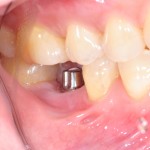
Dental implants require ongoing maintenance care to prevent the complications of peri-implant disease (mucositis and implantitis). Air polishing was introduced as an approach for the supra- and sub-mucosal cleansing of titanium implants using repeated application of either amino acid glycine or sodium bicarbonate powder to effect the removal of plaque. The aim of this review was to assess the efficacy of air polishing in the management of peri-implant disease.
Methods
Searches were conducted in PubMed and the Web of Knowledge supplemented with hand searches of the journals; Clinical Implant Dentistry and Related Research; Clinical Oral Implants Research; International Journal of Oral and Maxillofacial Implants; Journal of Clinical Periodontology; Journal of Periodontology.
Randomised controlled (RCT), or controlled (CCT) trials (split-mouth or parallel group designs) in humans comparing air polishing with control measures for the non-surgical treatment of peri-implant mucositis and peri-implantitis were considered. Study quality was assessed using the Cochrane risk of bias tool. The primary outcome considered was bleeding on probing (BOP) with changes in pocket depth (PD) and peri-implantitis mucositis as secondary outcomes.
Results
- 5 studies (6 publications) were included.
- 2 RCTs and one CCT considered non-surgical treatment of peri-implant mucositis.
- 2 RCTs non-surgical treatment of peri-implantitis.
- A narrative synthesis did not reveal any major improvement of bleeding index/ BOP or disease resolution following air polishing over mechanical debridement at mucositis sites.
- Meta-analysis (2 RCTs) found a weighted mean difference (WMD) in BOP favouring air polishing over control measures WMD = 23.83% (95% CI -47.47 to -0.20; p = 0.048; I2 = 56.88%). The WMD for PD was not significant.
Conclusions
The authors concluded:
the present systematic review and meta-analysis has indicated that glycine powder air polishing is as effective as the control treatments at mucositis sites. However, it may improve the efficacy of non-surgical treatment of peri-implantitis over the control measures investigated.
Comments
Previous systematic reviews have considered the efficacy of a range of non-surgical treatments for peri-implant disease (Dental Elf – 20th Oct 2014), while this current review only focuses on the use of air polishing. The searches were restricted to two databases and supplemented by hand searches of key journals so the use of a broader range of databases may have identified additional studies. Only 5 studies involving a total of just 165 patients were included, 91 patients in the peri-mucositis studies and 74 in the peri-implantitis studies. As a result the findings of this review should be interpreted with caution.
A recent systematic review (Dental Elf – 15th Apr 2010 ) suggested that the average prevalence of peri-implant mucositis disease was 43% (CI: 32-54%) and peri-implantitis was 22% (CI; 14-30%). The quality of the available evidence for the treatment of peri-implant disease from both this current review and previous review of non-surgical treatments is poor, which is disappointing considering how many implants are currently being placed and how common the problem is reported to be.
Links
Schwarz F, Becker K, Renvert S. Efficacy of air polishing for the non-surgical treatment of peri-implant diseases: a systematic review. J Clin Periodontol. 2015 Sep 12. doi: 10.1111/jcpe.12454. [Epub ahead of print] Review. PubMed PMID: 26362615.
Dental Elf – 15th Apr 2010 – Peri-implantitis: a common complication of dental implants?

Peri-implant disease: Limited evidence for the use of air polishing https://t.co/Wde39TuORx
Limited evidence for air polishing in peri-implant disease https://t.co/Wde39TuORx
Air polishing to manage peri-implant disease ? https://t.co/Wde39TuORx
Lack of good evidence for air polishing in peri-implant disease https://t.co/Wde39TuORx
Don’t miss- Peri-implant disease: Limited evidence for the use of air polishing https://t.co/Wde39TuORx
Peri-implant disease: Limited evidence for the use of air polishing – National Elf Service https://t.co/vCMTpaCPCx
[…] Dental Elf – 26th Oct 2015 – Peri-implant disease: Limited evidence for the use of air polis… […]